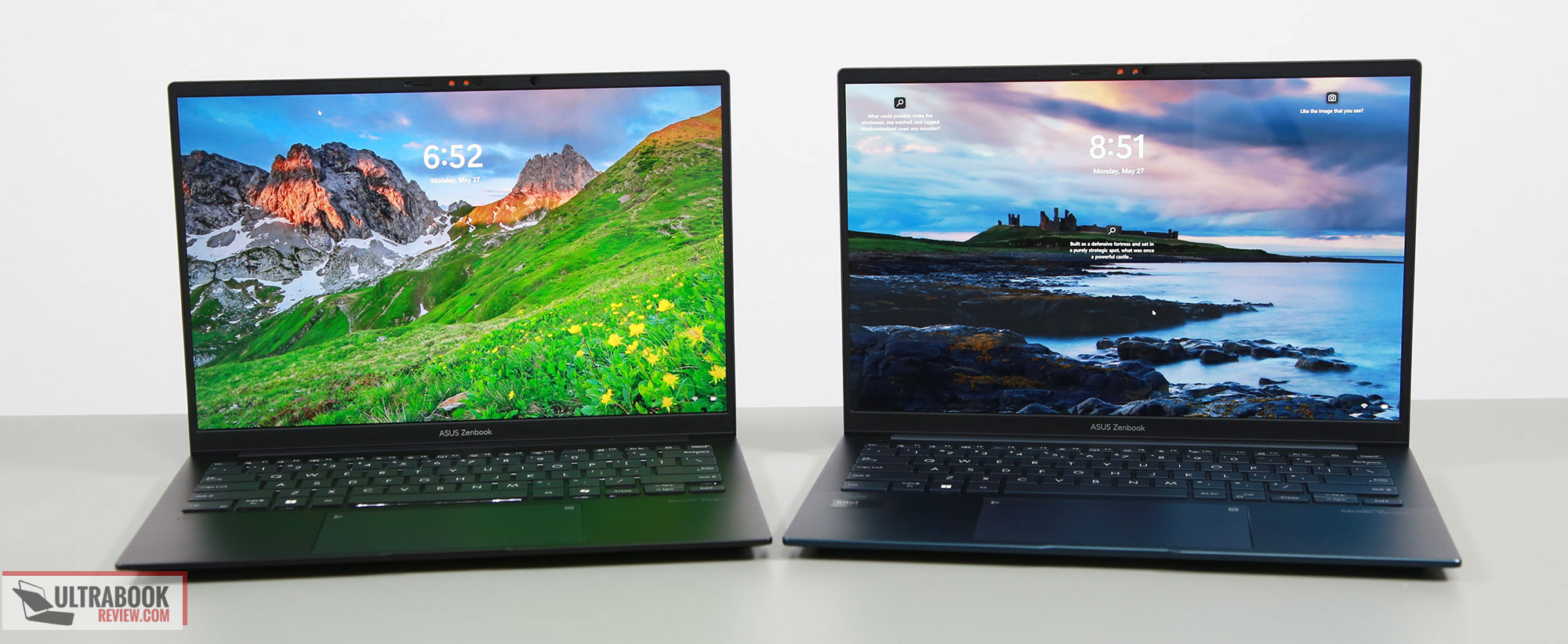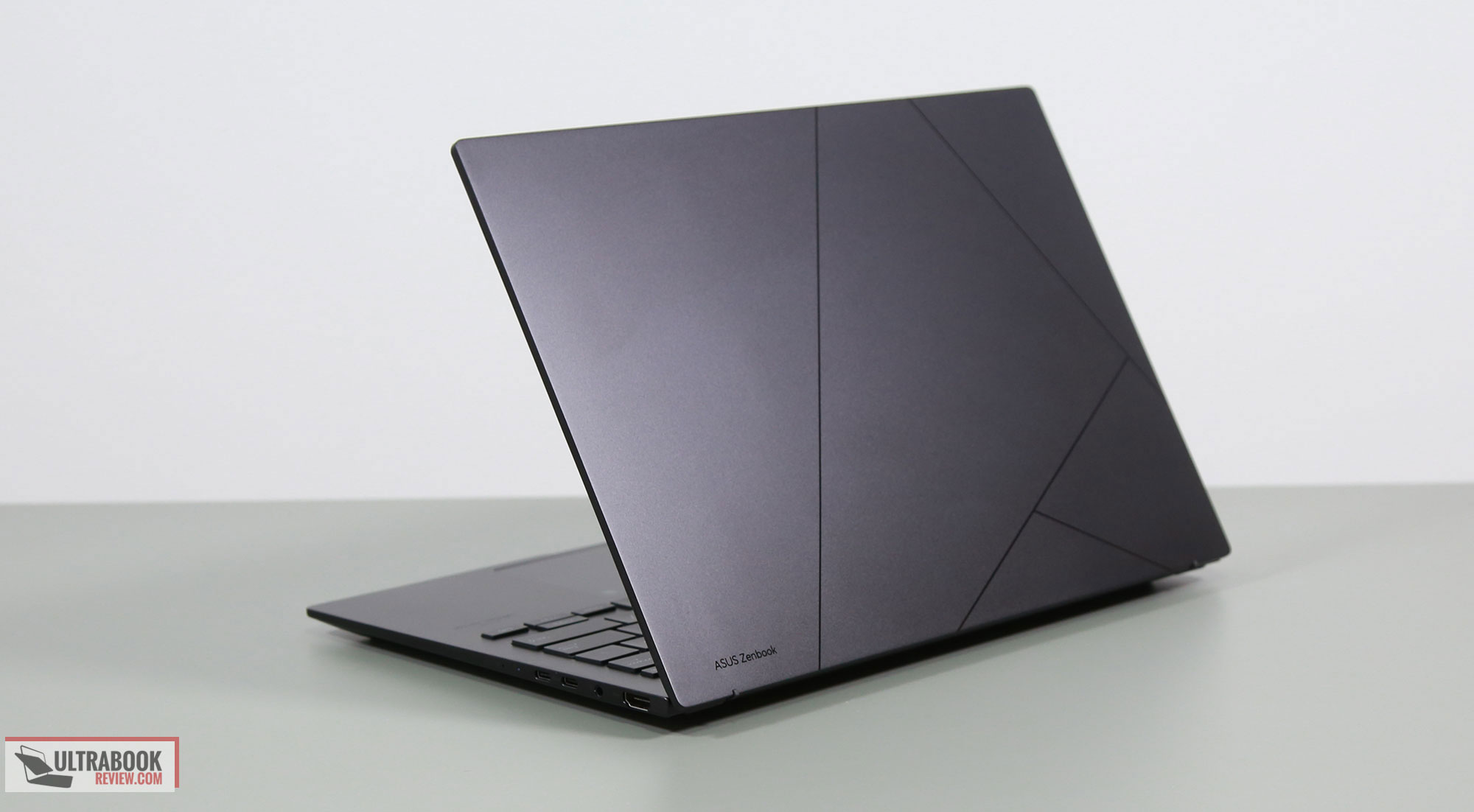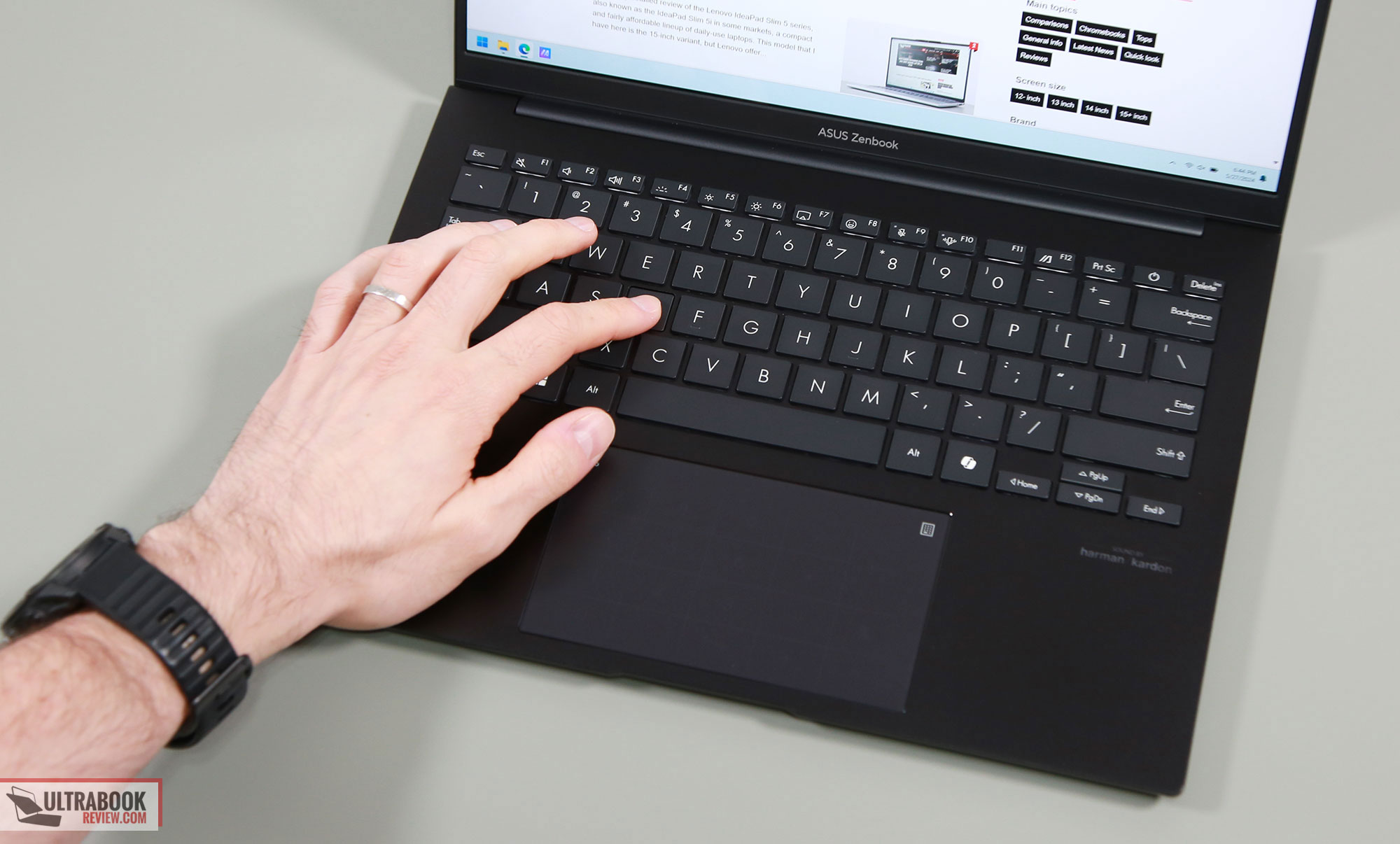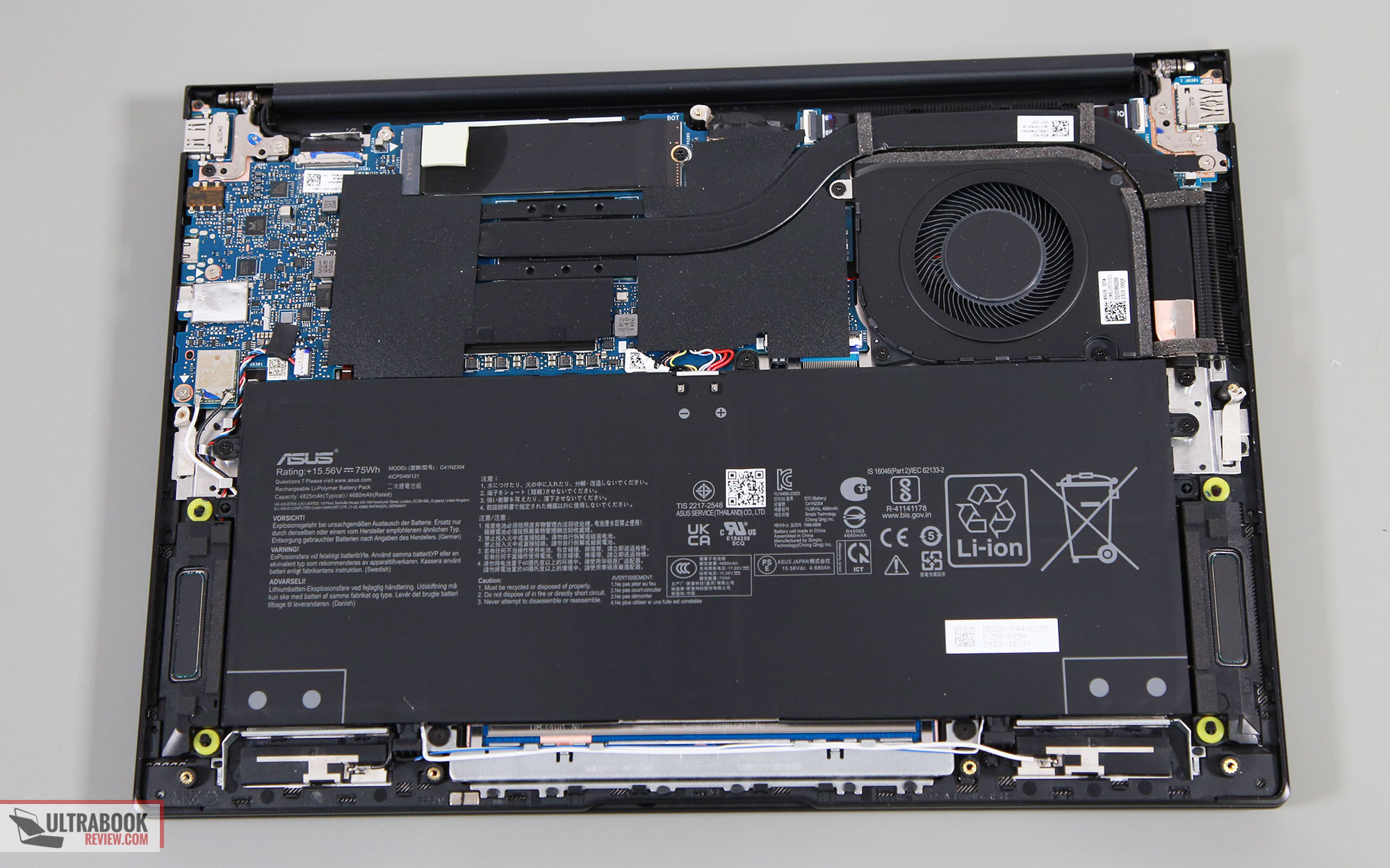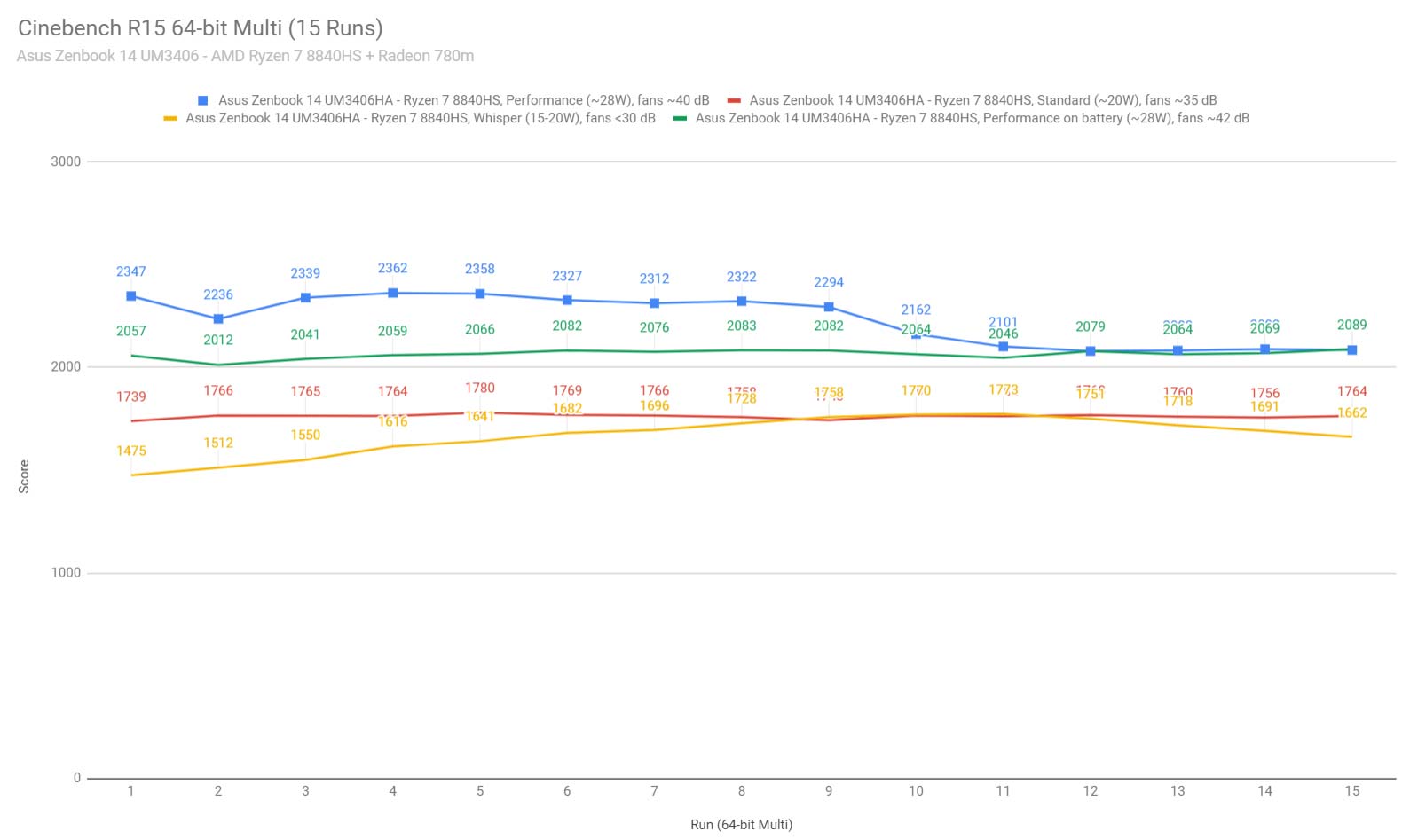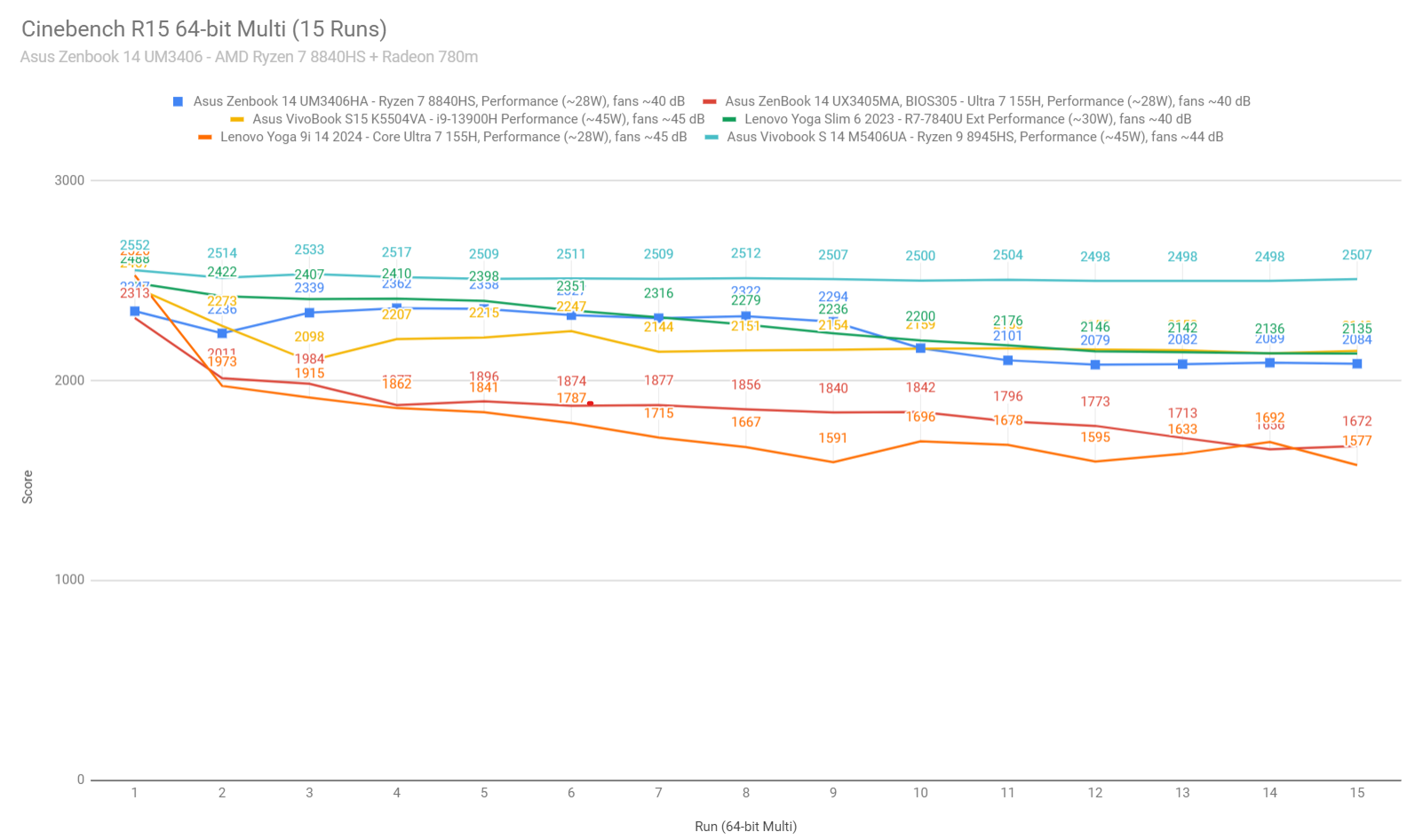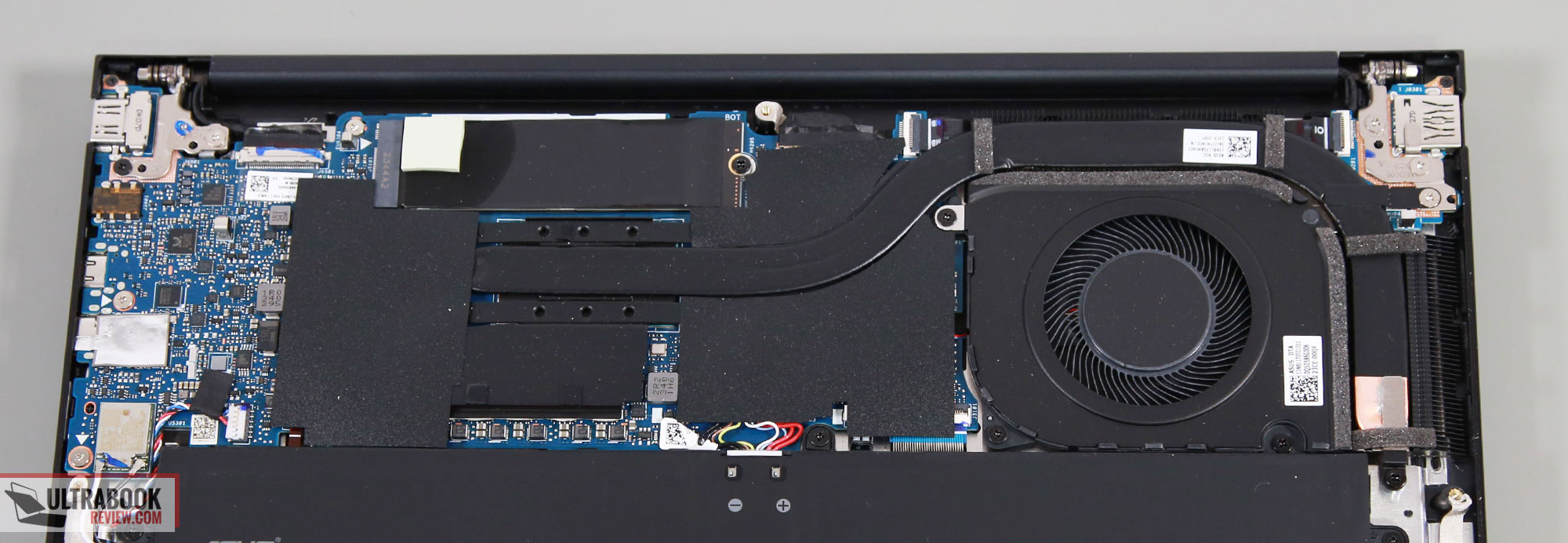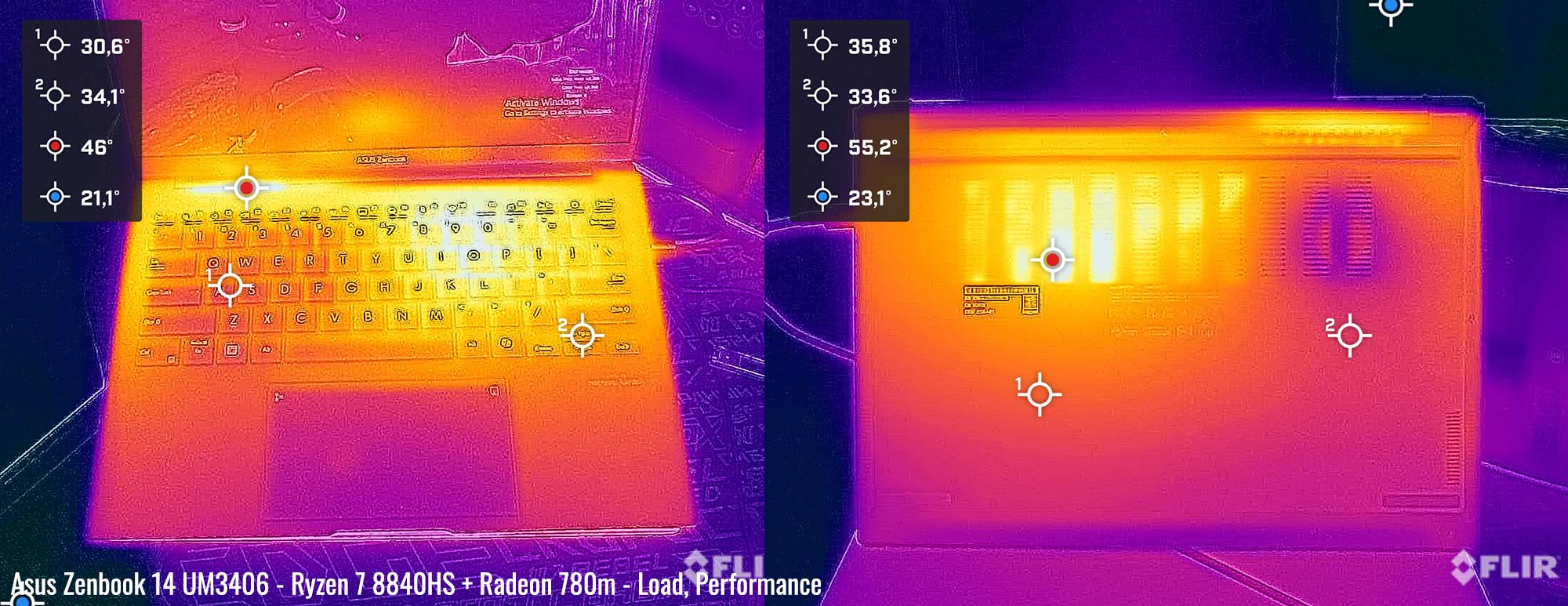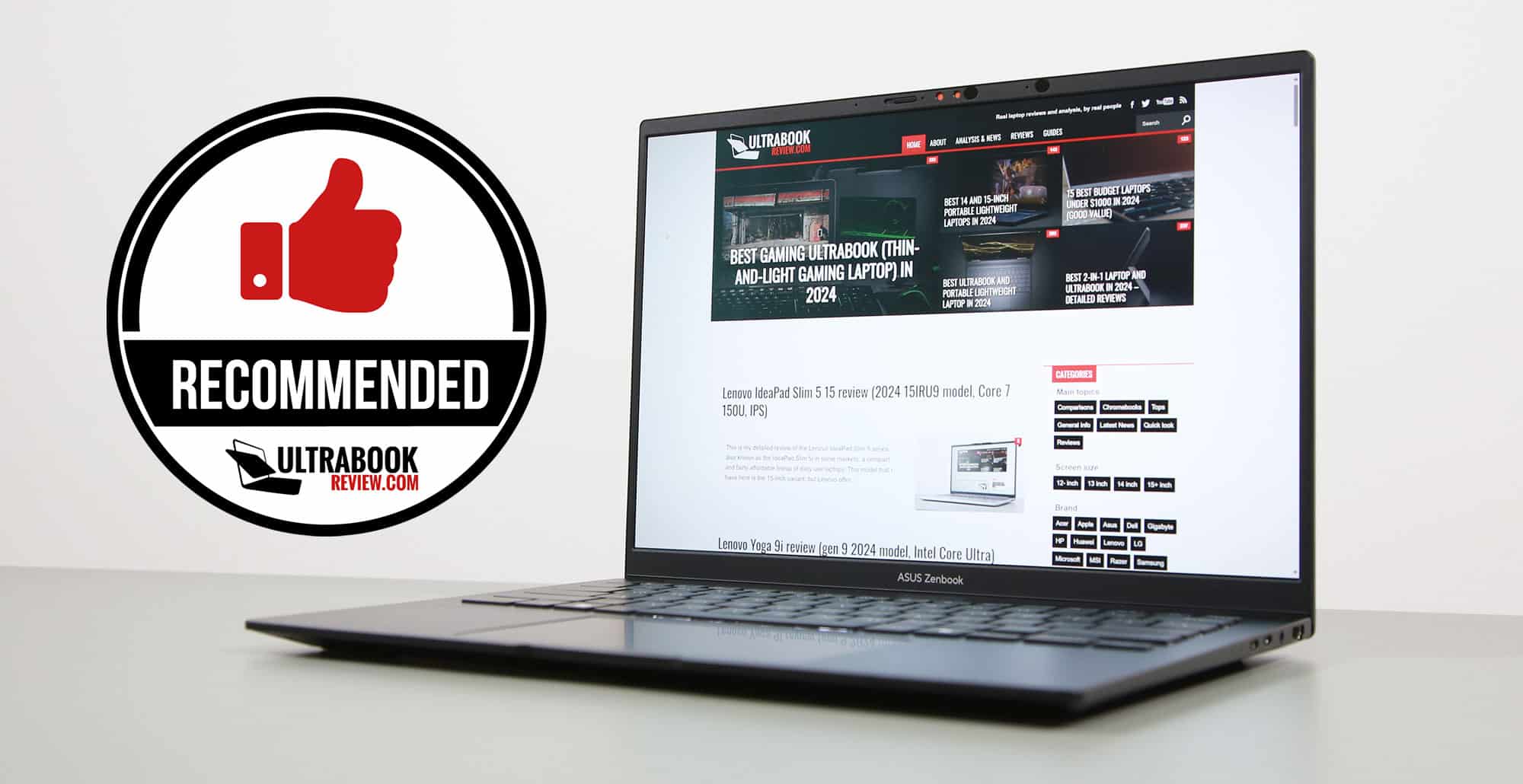This is my detailed review of the AMD-powered 2024 Asus Zenbook 14 OLED UM3406HA series.
This laptop is nearly identical to the Intel-based Zenbook 14 OLED UX3405 tested a while ago, with the same chassis and internal design, but a different color. That allows us to properly compare how the AMD Hawk Point hardware in this AMD model fares against the Intel Meteor Lake platform.
This unit here is a retail sample that I bought locally for this review, and maybe for keeping it. It retails over here for around 1200 EUR for the Ryzen 7 8840HS, 16 GB RAM, 1 TB SSD configuration, but I actually paid less than 1100 EUR for an pen-box unit, which is an excellent deal imo.
I’ve been using this for the last few weeks, and gathered my thoughts and impressions down below, where we’ll get in depth on all the aspects that you should know about this new Zenbook 14 UM3406 series
Specs as reviewed – Asus ZenBook 14 OLED UM3406 laptop
| Asus Zenbook 14 OLED review, UM3406HA series, 2024 model |
|
| Screen | 14 inch, OLED, 16:10 aspect ratio, non-touch, glossy, 2.8K 2880 x 1800 px, 120Hz refresh, 400-nits SDR brightness, 600-nits HDR peak, 100% DCI-P3 colors FHD+ OLED 60Hz panel, touch or non-touch, also available on some models |
| Processor | AMD Hawk Point, Ryzen 7 8840HS , 8C/16T, up to 5.1 GHz |
| Video | AMD Radeon 780m, 12 CU, up to 2.7 GHz |
| Memory | 16 GB LPDDR5x-7500 (soldered), up to 32 GB |
| Storage | 1 TB M.2 NVMe SSD (WD PC SN560) – single M.2 2280 slot |
| Connectivity | Wireless 6E (Mediatek MT7922) 2×2, Bluetooth 5.3 |
| Ports | left: 1x USB-A 3.2 gen1, right: 2x USB-C connectors, one with USB 4.0, 1x HDMI 2.1 TMDS, mic/headphone |
| Battery | 75 Wh, 65W USB-C charger |
| Size | 312 mm or 12.28” (w) x 220 mm or 8.66” (d) x from 14.9 mm or 0.58” (h) |
| Weight | 2.65 lbs (1.2 kg) + .36 (.8 lbs) for the USB-C charger and cables, EU version 2.8 lbs (1.28 kg) for the touchscreen models |
| Extras | clamshell format with 180-degree hinge, single-fan dual-radiator cooling, white backlit keyboard, 1.4 mm travel, glass touchpad with optional NumberPad, 2MPx FHD webcam with IR, ALS, and privacy shutter, no fingerprint sensor, stereo side/bottom firing speakers, Jade Black color |
Asus offers this laptop in a bunch of different hardware configurations over the various markets, with Ryzen 5 and Ryzen 7 processors, 8 to 32 GB of RAM, and several display options, either touch or non-touch and either FHD+ or 2.8K OLED panels.
Design, build quality – refined chassis and ergonomics
As mentioned earlier, this Zenbook 14 UM3406 series is identical in design and construction to the Zenbook 14 UX3405 lineup that I’ve already covered in-depth in this separate article.
The only important design differences between these are the color schemes, where this AMD model comes in Jade Black, and the Intel model is offered in a dark Blue color. Here are some pictures of the two side by side.
And of course, the other changes lie inside, with the two platforms and their derivatives, such as the fact that there’s no Thunderbolt 4 support on this AMD version, which instead gets an USB 4.0 port. Up to you if this matters or not.
These aside, I’m not going over all the design and construction particularities all over again in this article, you’ll find all my impressions in the previous review.
I will summarize that this is a refined Zenbook that addresses some of my complaints with the previous generations. This is a premium thin-and-light laptop that feels especially exquisite in this Black variant, but you’ll have to accept the smudges. The chassis still meets a bunch of MIL-SPEC criteria of durability and reliability, much like past Zenbooks did. And the metal surfaces get this anti-microbial coating that’s a newer perk to the lineup.
Ergonomics and excellent as well, with a sturdy chassis and lid, good grip, friendly edges, and a display that goes flat to 180 degrees.
You also get plenty of ports with this machine, lined on the sides, including USB-A and USB-C connectors, a full HDMI 2.1, and an audio jack. There is, however, no microSD card reader and no lock.
I’d just wish they were able to spread the USB-C ports on both sides, to give more optionality when plugins this in for charging. Instead, they placed most ports on the right edge, as the left is reserved for cooling output – and yes, that means hot air doesn’t blow into the display as on older Zenbooks, it goes to the side and away.
Keyboard, touchpad on the Zenbook 14 UM3406
Asus haven’t updated the inputs on their 2024 Zenbooks, which are identical to those on the past Zenbook 14 2023 generation, but that’s fine, as they were already some of the better available in 14-inch Windows devices.
The keyboard is a standard Asus layout, with proper spaced and sized main keys, smaller arrows, and without a Number Keypad. The keycaps are smooth to the touch and have a small ditch in them, and they’re black on this variant, color matched to the laptop’s overall color, which means they can show some finger-oil too.
The typing experience is as good as it gets for compact Windows laptops, with excellent feedback and average stroke-depth, at 1.4 mm. I also found this keyboard to be quiet-enough, even if not the quietest in the segment.
The lighting system is once more standard for an Asus portable laptop, with white LEDs and three brightness levels to choose from, as well as dedicated physical indicators for CapsLock and the microphones, but not for FnLock. Lighting uniformity is alright, better than on past implementations, but some light still spills out from underneath the keycaps, especially from underneath the top row of function keys.
The touchpad is a large glass surface, black in color as well, and smooth to the touch. It handles swipes, gestures and taps smoothly and without hiccups. It also didn’t rattle with firmer taps on this unit, and even the physical clicks in the corners are smooth and not that clunky. So overall, this is one of the best touchpads available in this segment today.
Furthermore, this touchpad acts a NumberPad – a virtual numeric keypad – if needed, a function enabled by pressing the activator zone in the top-right corner of the surface.
For biometrics, there’s no finger sensor in the power button with this generation of Zenbooks, but you do get a capable IR webcam with Windows Hello support.
Beautiful 120Hz OLED display
Asus remain faithful to OLED screens on their ultraportables and don’t offer any IPS panels anymore for this 2024 Zenbook generation. That means no matte display option, only glossy finishes, in either touch or non-touch implementations.
This unit is the non-touch variant of the 14-inch 2.8K Lumina OLED panel. The touch implementation, where offered, comes with an extra digitizer layer and a layer of protective glass on top of the panel, and that makes the lid a little thicker and adds about 100 grams the overall weight of the laptop.
Now, because this implementation is non-touch and lacks a digitizer layer, doesn’t suffer from the same graininess that I usually notice on touch OLED laptops, especially visible on whites. To be fair, though, the grain is no-longer that bad on the touch versions either with this 2024 OLED panels, surely not as visible as on past devices.
This aside, this panel is still a sharp OLED, with nearly 3K pixel resolution, beautiful colors and deep blacks and contrast. It’s still not that bright, though, at just a little over 400-nits sustained in this non-touch variant, which is about 10% brighter than the touch implementation. Asus mention 550-nits peak brightness in their marketing materials, but that’s peak-HDR brightness.
I’ll also mention that this is a 3K OLED screen with nearly instantaneous response times and 120Hz refresh rate. These make it a fine choice for gaming, especially paired with the updated Radeon iGPU in the AMD Hawk Point hardware.
Anyway, here’s what we got in our tests, with an X-Rite i1 Display Pro sensor:
- Panel HardwareID: Samsung SDC419D (ATNA40CU09-0);
- Coverage: 100% sRGB, 94.3% Adobe RGB, 100% DCI-P3;
- Type: 10-bit with HDR500, 120 Hz;
- Measured gamma: 2.23;
- Max brightness in the middle of the screen: 413.23 cd/m2 on power;
- Min brightness in the middle of the screen:
- Contrast at max brightness: 1:1;
- White point: 6500 K;
- Black on max brightness: 0 cd/m2;
- PWM: Yes, to be discussed.
The panel came well calibrated out of the box and turned up uniform in color and luminosity. Plus, since this is an OLED panel, you don’t have to concern yourself with light bleeding or blooming or other nuisances of IPS panels. If interested, this article goes indepth over the OLED panel technology available in laptops.
You do have to account for flickering on OLED notebooks, and even that is less of an issue on Asus devices if you’re using the flicker-free OLED Screen dimming option available in the myAsus app instead of lowering the brightness with the regular controls available in Windows.
Furthermore, I will note that the touch-versions of this laptop should include an Asus pen Stylus in the box, if that’s something you’re interested in. Although, that’s hardly useful on this sort of a clamshell format.
I’ll also add that Asus also offer a lower-tier OLED screen on some of the base-level configurations of this laptop, a FHD 60 Hz panel. It’s still an OLED, so it still displays beautiful colors and offers excellent blacks and contrast. It’s just not as sharp or as fast as this 2.8K 120Hz option. But it comes in more affordable, and helps with battery life as well.
Hardware and performance – AMD Hawk Point Ryzen processor, Radeon 780M iGPU
Our test model is a top-specced configuration of the 2024 Asus Zenbook 14, code name UM3406HA, with an AMD Ryzen 7 8840HS processor and AMD Radeon 780M integrated graphics, 16 GB of LPDDR5x-7500 memory, and a middling 1TB gen4 SSD.
Disclaimer: I bought this unit from a local store, so this is a retail unit. I tested it with the software available as of mid-May 2024 (BIOS 302, MyAsus 3.1.27.0 app). This is a fairly mature software package, as the laptop has been available in stores for a few months now.
Spec-wise, this series is based on AMD’s Ryzen 8000 Hawk Point hardware platform, with Ryzen HS processors and Radeon integrated graphics.
Our configuration is a AMD Ryzen 7 8840HS processor, a design with 8 Cores and 16 Threads. This processor is mostly a refined follow-up of the Ryzen 7 7840U implemented in some 2023 portable laptops. It runs at a fairly limited sustained power level here, at sub 30W, but is still an excellent performer for such a compact and lightweight computer, as you’ll see in a bit.
A lower tier AMD Ryzen 5 8645HS 6C/12T processor is also available on the more affordable configurations of the Zenbook 14 UM3406.
Graphics are handled by the integrated AMD Radeon 780M chip, which is the same iGPU from the 2023 AMD Phoenix platforms, and still a capable performer for its niche. Note that the Ryzen 5 configuration comes with Radeon 760M graphics, which is only about half the performance of the 780M.
Our configuration also comes with 16GBof LPDDR5-7500 memory, faster than on previous Zenbooks. 8 and 32 GB configurations are also available in some markets.
For storage, Asus opted for a mid-level PCIe gen4 WD PC SN560 SSD drive here, which is alright for regular use, but will struggle somewhat with sustained transfers.
The SSD is the only upgradeable component here, as the Wifi chip is no longer an M.2 format. To get inside you need to remove the back panel, which is held in place by a couple of Torx screws. All these screws are easily accessible now, and are no longer hidden underneath any of the rubber feet, as on previous Zenbooks. Just be aware that these screws are still of two sizes, so make sure you put them back in the right order.
Inside you’ll find the motherboard with the thermal module, the battery, speakers, and the SSD and WiFi slots. Everything is packed up nicely, with no space left unused.
As far as the software goes, this ZenBook gets the standard MyAsus app which allows control over the power profiles, battery and screen settings, updates, etc.
There are three performance/thermal profiles to choose from:
- Performance – allows the hardware to run at ~28W sustained, with the fan ramping up to ~40 dB;
- Balanced/Standard – allows the hardware to run at 20W in sustained loads, with the fan ramping up to ~35 dB;
- Whisper – limits the CPU at 15W to favor fan noise of sub 30 dB.
I’d recommend keeping the laptop on Standard in most cases, to prevent any stuttering or sluggishness that might come with Whisper mode. The Performance profile offers faster processing capabilities in sustained loads, but is also noisier. We’ll discuss the noise profiles further down, in the next section of the review.
We’ll get to that in a bit, but first, here’s what to expect in terms of speeds and temperatures with daily chores such as streaming video, editing text, or browsing the web.
Productivity Performance and Benchmarks – AMD Ryzen 8000 Hawk Point, Radeon graphics
On to more demanding loads, we start by testing the CPU’s performance in the Cinebench R15 loop test.
On the Performance mode, the AMD Ryzen 7 8840HS processor peaks at ~50W of power for brief seconds, and then gradually drops and stabilizes at around 28W in sustained loads, with temperatures in the high-70s Celsius, and fan-noise levels of ~40 dB. These result in sustained Cinebench scores of around 2100 points.
On Standard, the system limits the fan to around 35 dBA. The Ryzen 7 8840Hs quickly stabilizes at 20W, with temperatures in the high-60s C, and scores of around 1750 points. That’s about 80% of the scores of Performance mode.
On Whisper mode, the processor varies between 20 and 15W, with barely audible fans and temperatures up to low-70s C. The scores are between 60 to 75% of the Performance scores.
Finally, our sample performed very well on battery, stabilizing at around 28W of power on the Performance mode. That’s on par with the plugged-in Performance profile.
All these are illustrated in the graph below.
To put these in perspective, here’s how this Ryzen 7 8840HS implementation fares against other hardware platforms available in current and past-generation 14-inch thin and light laptops.
This is faster than Core Ultra 7 155H or Core i9-13900H platforms, but at the same time on par with last year’s Ryzen 7 7840U and slower than a Ryzen 9 8945HS (which runs at higher power).
We then went ahead and further verified our findings with the more taxing Cinebench R23 loop test and in Blender. We measured similar behavior, power limits, fan noise and temperatures.
We then ran the 3DMark CPU profile test.
Finally, we ran our combined CPU+GPU stress tests on this notebook, on the Performance profile. 3DMark stress runs the same test for 20 times in a loop and looks for performance variation and degradation over time. This unit easily passed the test, which means the performance is not impacted in longer-duration sustained loads, as the heat builds up.
Benchmarks results and performance summary
With that out of the way, let’s get to some benchmarks. We ran our standard set of tests with the laptop on Performance mode and the screen set at its default 2.8K resolution.
Here’s what we got.
- 3DMark 13 –CPU profile: max – 6906, 16 – 6989, 8 – 5669, 4 – 3532, 2 – 1841, 1 – 952;
- 3DMark 13 – Fire Strike: 7192 (Graphics – 7760, Physics – 25926, Combined – 2733);
- 3DMark 13 – Night Raid: 28522 (Graphics – 35536, CPU – 13613);
- 3DMark 13 – Time Spy: 3146 (Graphics – 2828, CPU – 8701).
- Uniengine Superposition – 1080p Extreme: 1605;
- Uniengine Superposition – 1080p Medium: 5231;
- PCMark 10: 7024 (Essentials – 10563, Productivity – 10058, Digital Content Creation – 8853);
- GeekBench 6.2.2 64-bit: Multi-core: 11485, Single-Core: 2494;
- CineBench R15 (best run): CPU 2347 cb, CPU Single Core 274 cb;
- CineBench R20 (best run): CPU 5711 cb, CPU Single Core 680 cb;
- CineBench R23: CPU 14626 pts (best run), CPU 13741 pts (10 min loop test), CPU Single Core 1756 pts (best run);
- CineBench 2024: GPU – pts, CPU 798 pts (best single run), CPU 758 (10 min run), CPU Single Core 104 pts;
- x265 HD Benchmark 64-bit: 25.65 s.
And here are some work-related benchmarks, on the same Performance profile:
- Blender 3.4.1 – BMW Car scene- CPU Compute: 2m 52s ;
- Blender 3.4.1 – Classroom scene – CPU Compute: 6m 51s;
- Blender 3.6.5 – BMW Car scene- CPU Compute: 2m 48s ;
- Blender 3.6.5 – Classroom scene – CPU Compute: 6m 41s;
- PugetBench – DaVinci Resolve: 567;
- PugetBench – Adobe Photoshop (25.5): -;
- PugetBench – Adobe Premiere (24.2.1): -;
- SPECviewperf 2020 – 3DSMax: 30.75;
- SPECviewperf 2020 – Catia: 34.06;
- SPECviewperf 2020 – Creo: 53.63;
- SPECviewperf 2020 – Energy: 18.84;
- SPECviewperf 2020 – Maya: 123.55;
- SPECviewperf 2020 – Medical: 21.84;
- SPECviewperf 2020 – SNX: 135.00;
- SPECviewperf 2020 – SW: 65.77;
This Zenbook is a solid performer for its class of portable and lightweight laptops.
As mentioned already, the AMD Hawk Point hardware is among the most capable available in this class, especially on the CPU side, in both single and multi-threaded loads.
On the GPU side, though, this year’s Radeon 780M is identical to last year’s chip, and still one of the better iGPUs available today. But, Intel’s Meteor Lake Core Ultra 7 and Ultra 9 processors with Arc iGPUs tend to outmatch the Radeon chip in most graphic-intensive loads, especially those in higher powered implementations.
Ryzen 7 8840HS performance vs. Core Ultra 7 155H, Ryzen 7 7840U
Here’s a comparison of these results with a few other Intel and AMD platforms available so far in this space.
| Zenbook 14 UM3406, AMD Ryzen 7 8840HS + Rad 780M, 28W Performance mode |
Zenbook 14 UX3405, Intel Core Ultra 7 155H + Arc, 28W Performance mode |
Zenbook 14 UX3402, Intel Core P i7-1360P + Xe, 30W Performance mode |
Zenbook 14X UX3404, Intel Core H i9-13900H + Xe, 45W Performance mode |
Yoga Slim 6, AMD Ryzen 7 7840U + Rad 780M, 30W Performance mode |
|
| 3DMark – Fire Strike | 7192 (G – 7760, P – 25926, C – 2733) | 8094 (G – 8768, P – 21127, C – 3234) | 5083 (G – 5442, P – 21800, C – 1923) | 5618 (G – 6043, P – 24479, C – 2094) | 7368 (G – 7919, P – 22331, C – 2893) |
| 3DMark – Time Spy | 3146 (Graphics – 2828, CPU – 8701) | 3497 (Graphics – 3179, CPU – 8104) | 1866 (Graphics – 1640, CPU – 8542) | 2029 (Graphics – 1774, CPU – 11107) | 3216 (Graphics – 2883, CPU – 9352) |
| Uniengine Superposition – 1080p Extreme | 1605 | 1884 | 1070 | 1156 | 1498 |
| CineBench R23 (best run) | 14626 cb – multi core, 1756 cb – single core |
12485 cb – multi core, 1692 cb – single core |
10512 cb – multi core, 1823 cb – single core |
14712 cb – multi core, 1860 cb – single core |
15194 cb – multi core, 1754 cb – single core |
| Blender 3.01 – Classroom scene – CPU Compute | 6m 41s | 8m 41s | 10m 01s | 7m 28s | 6m 20s |
| PugetBench – Adobe Photoshop | – | 1061 | 764 | 904 | 943 |
| PugetBench – DaVinci After Effects | 567 | 462 | 467 | 473 | 500 |
| SPECviewperf 2020 – 3DSMax: | 30.75 | 22.33 | 14.13 | 14.91 | 25.52 |
| SPECviewperf 2020 – Catia: | 34.06 | 16.39 | 13.26 | 14.08 | 29.78 |
| SPECviewperf 2020 – Maya: | 123.55 | 72.42 | 56.65 | 57.65 | 113.68 |
Standard mode, quieter at 35 dBA
This laptop runs quieter than other Zenbooks on Performance mode, at 40 dBA at head-level, but perhaps you might still be interested in an even quieter experience.
Here are some benchmarks results for the Standard mode, in which case the fans won’t go over 35 dBA:
- 3DMark 13 – Fire Strike: 6725 (Graphics – 7161, Physics – 24329, Combined – 2646);
- 3DMark 13 – Time Spy: 2899 (Graphics – 2609, CPU – 7836);
- Uniengine Superposition – 1080p Extreme: 1538;
- CineBench R20 (best run): CPU 5378 cb, CPU Single Core 672 cb;
- Blender 3.01 – Classroom scene – CPU Compute: 8m 02s.
You’re losing 5-20% of the processing power with this more power-limited profile, mostly in sustained CPU chores, but these scores are still higher than you’d get on most other portable designs of the last years. So it might make sense even for demanding loads.
There’s also the even quieter Whisper mode, in which case the fan won’t go over 30 dBA, but this is not a profile I’d use for intensive loads.
Gaming Performance
We also ran a couple of DX11, DX12, and Vulkan games on the Performance profile of this Ryzen 7 8840HS + Radeon 780M configuration, at FHD+ resolution, with Low/Lowest graphics settings. I threw in a few other platforms for comparison.
| Low settings | Zenbook 14 2024 – Ryzen 7 8840HS, Rad 780m, Perf – 28W, FHD+ 1200p |
Zenbook 14 2024 – Ultra 7 155H, Arc, 28W, FHD+ 1200p |
Zenbook 14X 2023 – i9-13900H, Iris Xe, 45W, FHD+ 1200p |
ZenBook S 13 2023 – i7-1355U, Iris Xe, 20W, FHD+ 1200p |
Lenovo Yoga Slim 6 2023 – R7-7840U, Rad 780M, 30W, FHD+ 1200p |
ZenBook S 13 2022 – R7-6800U, Rad 680M, 15W, FHD+ 1200p |
ZenBook 14 2022 – i7-1260P, Iris Xe, 30W, FHD 1200p |
| Dota 2 (DX 11, Best Looking Preset) |
76 fps (44 fps – 1% low) | 81 fps (58 fps – 1% low) | 74 fps (55 fps – 1% low) | 62 fps (32 fps – 1% low) | 72 fps (41 fps – 1% low) | 74 fps (46 fps – 1% low) | 76 fps (52 fps – 1% low) |
| Far Cry 6 (DX11, Low Preset, TAA) |
46 fps (34 fps – 1% low) | 43 fps (28 fps – 1% low) | – | – | 39 fps (29 fps – 1% low) | – | – |
| Horizon Forbidden West (DX12, Very Low Preset, TAA) |
35 fps (26 fps – 1% low) | – | – | – | – | – | – |
| Shadow of Tomb Raider (DX12, Lowest Preset, no AA) |
65 fps (48 fps – 1% low) | 54 fps (3o fps – 1% low) | 43 fps (28 fps – 1% low) | 26 fps (19 fps – 1% low) | 59 fps (34 fps – 1% low) | 47 fps (35 fps – 1% low) | 36 fps (23 fps – 1% low) |
| The Witcher 3: Wild Hunt (DX 11/12, Low Preset, TUAA) |
45 fps (33 fps – 1% low) | 44 fps (26 fps – 1% low) | 32 fps (23 fps – 1% low) | 29 fps (21 fps – 1% low) | 41 fps (24 fps – 1% low) | *41 fps (26 fps – 1% low) | *38 fps (20 fps – 1% low) |
- Doom, Dota 2, Witcher 3 – recorded with MSI Afterburner in game mode;
- Tomb Raider – recorded with the included Benchmark utilities;
- *Witcher 3 results for the 2023/2024 models are different than on previous devices, due to the changes brought to the game by the 2023 DX12 updates and patches.
Most games are playable here with these settings, including newer titles. But nonetheless, you can only expect so much from a portable laptop with integrated graphics today.
And btw, here’s what to expect if you plan on running games on the quieter modes.
| Zenbook 14 2024 – Ryzen 7 8840HS, Rad 780m, Low settings |
Performance – 28W, FHD+ 1200p, ~40 dBA |
Balanced – 20W, FHD+ 1200p, ~35 dBA |
Whisper – 15W, FHD+ 1200p, |
| Far Cry 6 (DX11, Low Preset TAA) |
46 fps (34 fps – 1% low) | 41 fps (30 fps – 1% low) | 28 fps (16 fps – 1% low) |
| Horizon Forbidden West (DX12, Low Preset) |
35 fps (26 fps – 1% low) | 30 fps (22 fps – 1% low) | 22 fps (16 fps – 1% low) |
| Shadow of Tomb Raider (DX12, Lowest Preset, no AA) |
65 fps (48 fps – 1% low) | 61 fps (48 fps – 1% low) | 43 fps (33 fps – 1% low) |
| The Witcher 3: Wild Hunt (DX 11/12, Low Preset, TUAA) |
45 fps (33 fps – 1% low) | 41 fps (30 fps – 1% low) | 30 fps (24 fps – 1% low) |
With that out of the way, let’s go through some CPU/GPU logs.
First, the Performance mode. The hardware stabilizes at around 28W of power, which is not quite enough to allow the GPU to work at its full potential. Instead, the Radeon 780M stabilizes here at around 2 GHz, roughly 75% of its full potential speeds of 2.7 GHz.
As far as noise and temperatures go, the fan still spins at 40 dBA with games, and the CPU stabilizes at temperatures in the high-70s C.
For what is worth, bumping the laptop off the desk helps significantly lowers the internal temperatures, which drop to high-60s to low-70s. Thus, I would advice placing the laptop on a stand for longer sessions of sustained work/gaming.
The Standard profile limits the processor’s power at around 20W, with a quieter fan at ~35 dBA. The GPU clocks average 20% lower than on Performance, which translates in a roughly 10-15% loss in framerates. The CPU runs a little cooler, in the low-70s, with the laptop flat ont he desk, and sub-70s with it on a stand.
Whisper mode is not meant for gaming, as it further caps the CPU power and as a result, the GPU only works at around 800 MHz in this mode. Noise levels and temperatures are lower, but that doesn’t matter.
And finally, this AMD Zenbook performs excellently on battery power, on Performance mode, pretty much on-par with the same profile with the laptop plugged-in.
Noise, Heat, Connectivity, speakers, and others
Asus went with a single-fan dual-radiator single-heatpipe thermal module here.
Compared to the previous Zenbook generation, they moved the heatpipe loop to the top of the fan, and thus were able to implement an extra heatsink at the top, alongside the one on the side. That allows this 2024 Zenbook to run at similar power levels and temperatures as the 2023 lineups, but with lower noise-levels.
At the same time, this remains a fairly minimalistic power design, and you will get more advanced cooling on other devices in this class, including the Asus Zenbook 14X (which, however, hasn’t been updated yet to 2024 hardware), the Lenovo Yoga 9i or the HP Spectre x360 14.
For comparison, here are the cooling modules on the 2023 Zenbook 14 and Zenbook 14X models.
All in all, though, the cooling module on this Zenbook 14 is good enough for this chassis, delivering consistent performance and keeping everything within acceptable thermal and noise limits. But, as mentioned earlier, I would recommend placing this on a stand when running longer work/gaming sessions, for better airflow underneath the chassis and into the fans, which results in lower internal and external temperatures.
As far as the noise levels go, expect 40 dBA on Performance, 35 dBA on Standard, and sub 30 dBA on Whisper mode.
With daily use, the fan keeps mostly idle on all profiles, but kicks in with heavier multitasking, especially on Performance with the laptop plugged in. I haven’t noticed coil winning or electronic noises on this unit.
As for external temperatures, the chassis keeps cool with light use.
*Daily Use – streaming Netflix in EDGE for 30 minutes, Whisper Mode, fans at 0 dB
With demanding loads, this laptop runs acceptably warm on Performance mode, with a hotspot of 45+ C in the top side of the chassis, around the hardware and the rear radiator. The bottom runs quite hot, though, at 55+ over the CPU.
Those are with the laptop flat on the desk, and will be lower if you place it on a stand. Temperatures will also be lower on the Standard mode, which is still competitive for demanding loads and games.
Overall, while these temperatures aren’t low by any means, they’re fine for this sort of chassis. And as mentioned several times already, placing this notebook on a stand will allow for even better thermals than what we measured here.
*Gaming – Performance mode – playing Witcher for 30 minutes, fans at ~40 dB
For connectivity, there’s the latest-gen Wi-Fi 6E and Bluetooth 5.2 through a Mediatek module on this laptop. This performed fine during my time with the laptop, but there were reports of inconsistent behavior with these MediaTek chips in the past. That can be a potential issue, since the wifi module is not a standard M.2 format anymore on this generation.
Audio is handled by a set of stereo speakers that fire through grills positioned on the side of the chassis. They sound alright for this class, with good volumes and quality. They’re also a bit punchier and richer than the speakers on the previous Zenbook 14 generation.
Finally, there’s an FHD camera placed at the top of the screen, flanked by microphones. The image quality is fine in good lighting, and still usable in bad light. There’s also IR functionality with Windows Hello support offered here, as well as a physical privacy cover. On top of these, an ALS sensor is also part of the camera ensemble.
Battery life – excellent runtimes with Hawk Point
There’s a 75 Wh battery inside this 2024 Asus Zenbook 14, properly sized for its segment.
Here’s what we got in our battery life tests, with the screen’s brightness set at around 120 nits (~50 brightness) and at its default 120Hz refresh rate. I’ve also set the Windows 11 power modes on Best Power Efficiency.
- 5 W (~15 h of use) – idle, Standard Mode, screen at 50%, Wi-Fi ON;
- 6.5 W (~12 h of use) – text editing in Google Drive, Standard Mode, screen at 50%, Wi-Fi ON;
- 6 W (~12 h of use) – 1080p fullscreen video on Youtube in Edge, Standard Mode, screen at 50%, Wi-Fi ON;
- 6 W (~12 h of use) – Netflix fullscreen in Edge, Standard Mode, screen at 50%, Wi-Fi ON;
- 9W (~6-8 h of use) – browsing in Edge, Standard Mode, screen at 50%, Wi-Fi ON;
- 38 W (~2 h of use) – Gaming – Dota 2, Standard Mode, screen at 50%, Wi-Fi ON.
These are excellent runtimes, thanks to the efficiency of the AMD Hawk Point hardware platform and that big battery. They’re also mostly on par with what we measured on the Intel Meteor Lake version.
As a side note, the screen doesn’t automatically switch from 120Hz refresh on battery power, but you can do this manually if looking to push the runtimes a little further.
The laptop ships with a compact 65W USB-C charger. It’s a single-piece design with a long and thick cable and an USB-C plug. A full charge takes about 2 hours.
Price and availability- Asus Zenbook 14 OLED
At the time of this article, the Asus ZenBook 14 UM3406HA is listed in some stores.
This exact configuration reviewed here, Jade Black and with the Ryzen 7 / 16 GB RAM / 1 TB SSD configuration and the 2.8K OLED display, is available here in Europe for around 1200 EUR.
A very similar model, but with the FHD+ OLED panel in a touch implementation is listed at $999 on Asus’ US webstore.
Furthermore, Wallmart also seems to have exclusivity at this point on a configuration with the same Ryzen 7 processor, 16 GB of RAM and FHD OLED panel, but with only 512 GB of SSD storage, for $799 at the time of this article.
Other configurations should be available as well over the different regions. But overall, all these models are aggressively priced and overall more affordable than the Intel-based Zenbook 14 UX3405 versions.
Follow this link for updated prices and configurations in your area.
Final thoughts- Asus Zenbook 14 OLED UM3406 review
Much like the Intel-based UX3405 lineup, this 2024 Zenbook 14 UM3406 model is a result of multiple updates and refinements over generations of 14-inch Zenbooks, and overall one of the best mid-range laptops in its class of portable and compact daily drivers that won’t break the bank for you.
Even more than the Intel-model, this AMD configuration is more powerful in multitasking and heavier CPU loads, and a little more affordable due to the configuration choices offered in most markets – but that means you’ll rarely find this with the 2.8K OLED panel or with 32 GB of RAM, which are more widely offered with the UX3405 series. Plus, this variants comes in a sober and exquisite Jade Black color that I for one would enjoy on my laptop, even with all the smudges involved.
Hence, this Zenbook 14 OLED UM3406 earns our clear recommendation. There’s nothing important wrong with it, and even the nitpickers among you will have a hard time findings it faults. Really, this is a solid ultrabook with a competitive price.
That’s about it for my review of the 2024 Asus Zenbook 14 OLED UM3405HA series. Looking forward to your thoughts and feedback and questions in the comments section down below.

